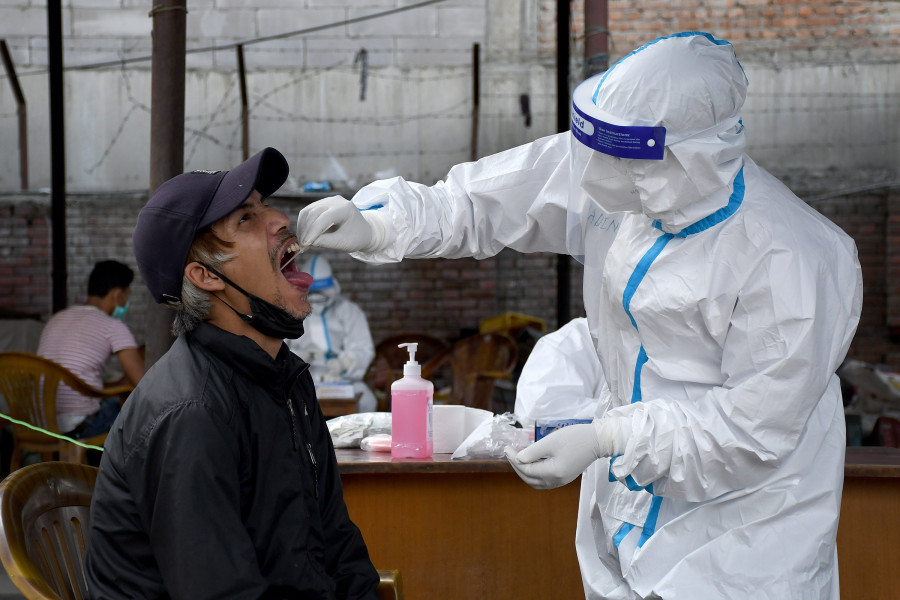Editorial
Covid-19 isn’t over
A third wave will be deadlier given the low vaccination coverage.
With the daily positive percentage hovering around 20 percent, Nepal’s epidemic curve has only dipped to the levels that we saw in the second fortnight of April as the second wave took hold. And although hospital admissions, including those in need of critical care, have receded, the decline in new cases, however, is primarily due to inadequate testing and tracing, according to epidemiologists who warn that a third wave is inevitable. The perilous situation calls for Covid-appropriate decisions, both from the government and the public. That a third wave is preventable cannot be overstated, but we must act swiftly to avert another humanitarian crisis. And we need to be guided by epidemiological data as we gradually relax restrictions after a two-month shutdown.
Given our epidemiological reality, we have to accept that the pandemic is far from over. There have been 638,805 confirmed infections and 9,112 Covid-19 related deaths as of Wednesday, with the highest surge in new infections and deaths last month alone. And although the gradual decline in cases, owing to fewer tests, could give us a false sense of security, data show that the positive rates across the seven provinces continue to be way higher than the permissible limit of 5 percent. As such, a third wave will be deadlier given the low vaccination coverage of just about 9 percent of the 30 million population, and only 2.6 percent of the people have been administered both doses.
With the nearest window to secure life-saving vaccines doses nowhere closer than 2022, our risks have only grown with the threat of new Covid-19 variants in transmission. The predominant variant of the coronavirus currently in circulation in Nepal is deadlier and more transmissible Delta variant which is spreading globally and hints at a bigger problem for the world. Its sub-lineage and more infectious K417N mutation, also known as “Delta Plus” (AY.1), have also been confirmed in swab samples of nine infected people in the country besides the Alpha and Kappa variants. According to the Health Ministry, these variants are more infectious and affect people of all age groups, and were also responsible for the exponential surge in new infections and deaths earlier in May.
Talking to this paper on Tuesday, Balananda Sharma, the newly appointed coordinator of the Covid-19 Crisis Management Centre, rightly said that the relaxation of the lockdown is a balancing act between health and livelihood. People have been jobless or deprived of their wages due to the closure, and for lack of government support, the most marginalised are dependent on volunteers for their next meal. But Sharma, a retired lieutenant general and his team, which comprises mainly security forces, also need to gauge the reality through the lens of epidemiologists and the Epidemiology and Disease Control Division of the ministry. For a slight carelessness by any individual would have us right where we were in May.
Epidemiologists have long warned of the third wave. There are concerns that it could hit children as the number of cases in the age groups 0-9 and 10-19 have risen sharply during the second wave. While there is no evidence that children will be exclusively affected, we need to be mindful that the Health Ministry reports 1,792 new infections on average each day. But a second week into the "smart lockdown", things are starting to look like Covid-19 is over. Mobility has increased with relaxed restrictions despite reservations from health officials. Markets and offices are crowded. Public vehicles, hotels and restaurants flout safety protocols, and sporadic protests have resumed with the deteriorating political climate. The way things are, it could very well be a countdown for our situation to get worse and, no sooner, another lockdown.
Nepal desperately needs a robust approach to deal with the pandemic, one where we are prepared to respond should a third wave hit, and more importantly, an effective and safe strategy to keep our markets open and the economy afloat. If this is our goal, our decisions and actions must reflect the means.




 18.12°C Kathmandu
18.12°C Kathmandu














